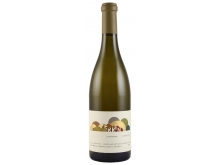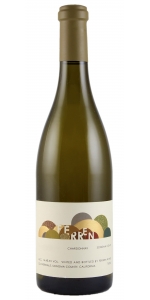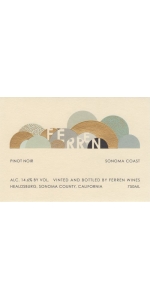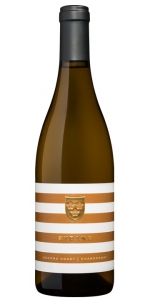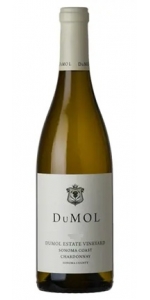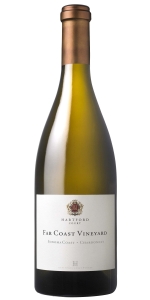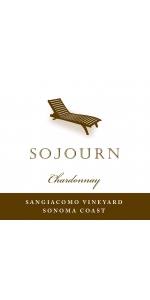Ferren Chardonnay Sonoma Coast 2020
6 bottles with free shipping for: $540.00
12 bottles with free shipping for: $1,020.00
| BUY MORE! SAVE MORE! | ||||||||||||||||||||
|
| Country: | United States |
| Regions: | California California (Sonoma County) |
| Winery: | Ferren Wines |
| Grape Type: | Chardonnay |
| Vintage: | 2020 |
| Bottle Size: | 750 ml |
Ferren Chardonnay Sonoma Coast is made from 100 percent Chardonnay.
The Sonoma Coast bottling is a blend of barrels from Ferren's single vineyard offerings; Lancel Creek, Silver Eagle, Volpert, and Frei Road Vineyards. The wine is always somewhat more approachable early in its life as less new oak is used in the blend. Pure and translucent fruit is the hallmark of this cuvée. Citrus, quince, sea spray, and minerals are buoyed by refreshing acidity and a seamless finish.
Ferren is a winery dedicated to tiny lots of artisanally made single-vineyard Chardonnay and Pinot noir wines from the far Sonoma Coast of California. Each of the vineyards in the portfolio is a jewel of the true Coast, has been hand picked based on its potential for producing profound, age-worth wines, and is farmed to the highest standards of sustainability and wine quality.
Date Founded: 2013
Winemaker Matt Courtney founded Ferren with longtime friend David Wherritt after an eight-year apprenticeship with Helen Turley at Marcassin Vineyard on the Sonoma Coast. The wines are made using traditional Burgundian methods without fining or filtration, and fermentations are carried out exclusively by native flora that arrive on the grapes from the vineyards.
SILVER EAGLE VINEYARD
Silver Eagle Vineyard rests atop Stoetz Ridge, the land mass that divides the remote Sonoma Coast from the Russian River Valley. This vineyard experiences both the cooling ocean breezes of the nearby Pacific, as well as the warmth of the interior valley. The wine made from this unique confluence of climates is extraordinary: the Pinot noir a rare balance of explosive wild berry, mouth-watering acidity, and rich, polished tannins; the Chardonnay a fascinating juxtaposition of briny minerality and candied citrus.
Our brilliant vineyard manager Ulises Valdez owns this vineyard, and has built his home on this spectacular site.
Ferren Chardonnay Sonoma Coast is made from 100 percent Chardonnay.
The Sonoma Coast bottling is a blend of barrels from Ferren's single vineyard offerings; Lancel Creek, Silver Eagle, Volpert, and Frei Road Vineyards. The wine is always somewhat more approachable early in its life as less new oak is used in the blend. Pure and translucent fruit is the hallmark of this cuvée. Citrus, quince, sea spray, and minerals are buoyed by refreshing acidity and a seamless finish.
Ferren Pinot Noir Sonoma Coast is made from 100 percent Pinot Noir.
100% native fermentation (primary and secondary), long cool fermentations often lasting up to a full year, minimal lees stirring, no additions of any kind (commercial yeast, water, acid, enzymes, etc., never any fining or filtration). Aged 18 months in 15% new French oak (Francois Freres, Vosges, Troncais Forrests)
Review:
"This red's pure beam of mulberry, griotte and blood orange pâte de fruit is racy, fresh and in perfect alignment as the flavors pick up dried anise, bergamot and iris accents along the way. Captivating for its combination of range and restraint, with a long, streamlined finish that ripples with subtle tension. Drink now through 2032. - James MOLESWORTH”
- Wine Spectator's insider (May 22nd 2024), 95 pts
#96 - Wine Spectator Top 100 of 2024
Bydand Chardonnay Sonoma Coast is made from 100% Chardonnay
Aged for 16 months in 30% new French oak, 70% neutral French oak
Farmed by one of California’s most respected and longest operating grape-growing families, the Roberts Road Vineyard is located in the Petaluma Gap. Sitting on well draining gravel soils, coastal winds allow for a long, slow and even growing season. Planted in 1998 these Dijon 95 grapes provide minerality and vibrancy to a full-bodied wine with impressive purity of flavor and mouth-feel. French oak barrels add subtle toast to aromas of pear, stone fruits and white citrus.
Winemaker’s Notes
Our organically farmed high-density Estate parcel sits at the top of the ridge amongst the diverse coastal forest. Although the soil is sandy, there’s a vein of clay in the subsoil that holds winter rain and allows us to dry-farm the vines. The tight spacing keeps the clusters and soil shaded during the summer heat, which allows the fruit to retain all the nuance of the site. The wine produced here has a character - a signature - all to itself and cannot be replicated elsewhere; it's the antithesis of fruity, forward, easy-to-understand Californian Chardonnay. The grapes are small with thick skins, producing a high level of fruit extract, which translates to deep texture and structure in the wine itself. Concentration allied to freshness is the essence of this wine, and it ages beautifully in bottle for ten to twelve years.
The wine’s aromas and flavors are incredibly complex and diverse, akin to citrus oil, preserved lemon, sage, fennel and caraway. The wine is deep, powerful, and layered with oyster shell freshness cutting through the natural density. Lemongrass, spearmint, and grapefruit power the finish, which pulsates with intensity. You could decant this for an hour before serving to hasten its development. Drink between 2025 and 2030. Serve no cooler than 55º F.
Review:
From a site surrounded by dense forest on two sides, the 2022 Chardonnay DuMOL Estate Vineyard is a bright straw hue and has a more vibrant aromatic nose of fresh mint, bright lime, flint, crushed stones, and white peach. Medium to full-bodied, it boasts a remarkably firm structure with a bit of tannin, a chalky texture, and a savory slanting profile, and it’s long and persistent on the finish. It has an assertive but crystalline feel and a crunchy brightness. It demands a bit of time. Drink 2025-2035.
-Jeb Dunnuck 96 Points
Hartford Court Far Coast Vineyard Chardonnay is made from 100 percent Chardonnay.
The 2019 Far Coast Vineyard Chardonnay exhibits aromas of orange zest, yellow apple, dried fruits, and spice. The flavors of tangerine, mandarin orange, and quince are followed by a long textural finish of minerals and delicate fruit.
Review:
This vineyard is located on a mountain ridge north of Fort Ross on the Sonoma Coast at 700 feet elevation, and the wine was aged for 14 months in 39% new French oak. The 2019 Chardonnay Far Coast Vineyard offers more lime citrus, saline minerality, and white peach, and the palate is fresh, energetic, and consistent with the nose. Texture-wise, it is markedly different, with more focused structure and tension.
-Jeb Dunnuck 96 Points
Sojourn Chardonnay Sangiacomo Vineyard is made from 100 percent Chardonnay.
The core of Sojourn Sangiacomo Vineyard Chardonnay is from the same vineyard source as the highly-acclaimed Sojourn Sangiacomo Vineyard Pinot noir wines. This wine features a combination of Clone 95 Chardonnay from Sangiacomo Roberts Road Vineyard and Old Wente Clone from Sangiacomo Vella Ranch. The Roberts Road block, planted in 1998, provides minerality and vibrancy. The Old Wente Clone selection is known to produce distinctively small clusters, low yields, and results in elegant, complex wines that round out this blend. These ranches are perfectly suited for growing Chardonnay, with cool climates and well-draining soils.
Sojour Chardonnay is fresh and lively, fruit-forward with bright acidity, stone fruit, citrus and apple flavors that leave your mouth watering.
- back
The Prisoner Wine Company The Prisoner Red Blend is made from a blend of Zinfandel, Cabernet Sauvignon, Petite Sirah, Syrah, and Charbono.
Bright aromas of ripe raspberry, vanilla, and coconut give way to flavors of fresh and dried blackberry, pomegranate, and vanilla, which linger harmoniously for a smooth and luscious finish.The Prisoner Red Blend was inspired by the wines first made by the Italian immigrants who originally settled in Napa Valley. The Prisoner is now the most recognized red blend, leading the resurgence of interesting blends by incorporating Zinfandel with the unlikely mix of Cabernet Sauvignon, Petite Sirah, Syrah, and Charbono.
On the nose, dried blackberry, dried açai berries, and hints of cedar and tobacco leaf are accented by sweet spices of clove, cinnamon, and nutmeg. Flavors of ripe dark cherry, blackberry coulis, and hints of anise linger harmoniously for a soft, vibrant finish balanced by ripe tannins.
Chef Brett recommends pairing The Prisoner Red Blend with Kalbi Short Ribs or Chicken Mole Tostada.
Vineyards: When you outgrow winemaking tradition, you must forge your own path. And we did. The Prisoner exists because of the collaboration with our growers, many of which have been with us since the very beginning—from the Solari Family Vineyard in Calistoga, where old school sensibilities meet new techniques, to the Korte Ranch in St. Helena, a vineyard whose diligence outlasted the Prohibition and has sustained four generations.
La Crema Fog Veil Pinot Noir is made from 100 percent Pinot Noir.
A lush, earthy, and balanced Pinot Noir from select estate vineyards in California's famous Russian River Valley. This red wine opens with aromas of wild strawberry, blackberry, and cardamom. Flavors of boysenberry, raspberry, and sassafras with hints of baking spice. Soft tannins are balanced by vibrant acidity. This Red Wine has a Cork closure. Alcohol Content: 14.8% Pair with grilled filet mignon, bacon wrapped pork tenderloin and camembert. Aromas of wild strawberry, blackberry, and cardamom. Flavors of boysenberry, raspberry, and sassafras with hints of baking spice. Soft tannins are balanced by vibrant acidity.
Review:
Tremendous energy is conveyed through a guiding light of spiced cher- rywood and notes of tea leaves and flint. Rich and concentrated, with a hint of smoked cedar on the finish. The grapes come from neighboring estate vineyards in the Santa Rosa Plains region of the Russian River Valley.
-Tasting Panel 94 Points

